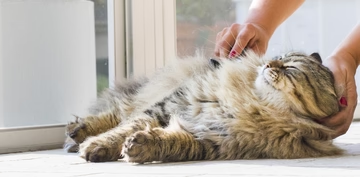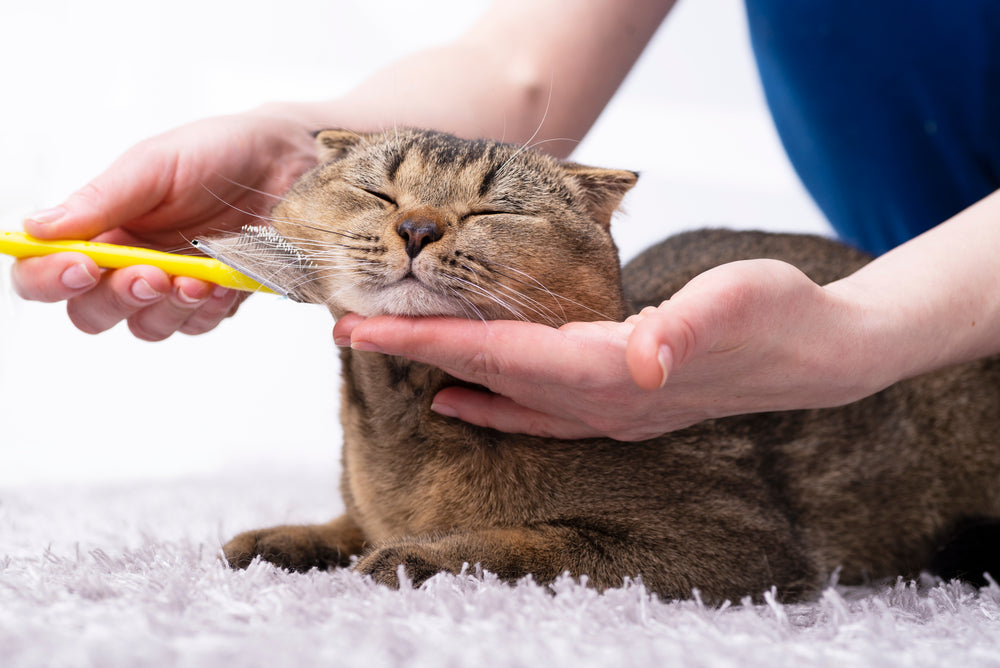9 Min Read
How To Detangle or Remove Matted Cat Fur
Key takeaway
Matted cat fur looks scary and unsightly, but it isn’t just a cosmetic issue. Matted cat fur can be extremely uncomfortable and even painful for your cat. If left untreated, it can cause skin irritation and inflammation, leading to infections and other skin issues. Brush out small mats using metal combs or remove big mats using electric clippers.

Why pet owners are switching to online vet care with Dutch
-
Prescriptions delivered free to you
-
Fast access to Licensed Vets over video
-
Unlimited video visits and follow-ups
Cats are excellent at grooming and spend around 30 to 50 percent of their day cleaning themselves.1 Not only does grooming keep their fur looking shiny and clean, but it also promotes circulation and helps them regulate their body temperature.2
How well or how much a cat is grooming can give you insight into their health and well-being. While aggressive grooming may be due to cat anxiety, too little grooming can indicate a host of underlying medical issues and lead to matted fur.
Matted cat hair, if left untouched, can be very uncomfortable and even painful for your cat. Tugging and pulling at their skin as they go about their day, the pad of matted fur can lead to skin irritation and inflammation as it grows tighter and bigger. You want to provide your cat relief as soon as possible, but how do you get rid of matted cat hair?
In this blog post, we will take a look at the different causes of matted cat hair, guide you through a step-by-step process on how to get mats out of cat fur, and end with some prevention tips. Matted fur won’t go away on its own, but de-matting a cat can take a lot of patience and concentration. If your cat’s fur is extremely matted or if you are having a hard time getting them to cooperate, it’s best to take your feline friend to a veterinarian or experienced cat groomer to ensure their safety.
- Why Does My Cat Have Matted Fur?
- How To Get Mats Out of Cat Fur
- How to Prevent Future Mats
- Matted Cat Fur: Frequently Asked Questions
- Final Notes
Why Does My Cat Have Matted Fur?
Cat matted fur is a densely tangled mess of hair, dead skin cells, dirt, dust, and anything else your cat has rubbed against or rolled in. Big pads of matted fur can obstruct airflow to your cat’s skin, leading to irritation, inflammation, and infection. If moisture cannot reach your cat’s skin, it will become dry, scaly, and flakey.
Conversely, moisture trapped beneath matted cat hair creates a perfect environment for bacteria, potentially resulting in skin infections such as hot spots.3 Matted fur near your cat’s backside can even hold on to urine and feces, affecting your cat’s hygiene while attracting bugs and parasites.
The first step to understanding how to get rid of matted cat fur is recognizing the cause. Unfortunately, there is no singular cause for matted fur in cats. Anything from the weather to your cat’s breed can make them more susceptible to matting. Knowing what’s causing your cat to have matted fur can help you rule out the possibility of any underlying illnesses and allow you to get them prompt veterinary care if needed.
Here are some of the most common causes of matted fur in cats:
Breed
Long-haired cats, curly-haired cats, and cats with a dense undercoat need more grooming to keep their fur from matting. Some cat breeds that need special attention in the hair department include:
- Birmans
- Maine coons
- Persians
- Ragdolls
- LaPerms
- Devon rexes
- Cornish rexes
- Turkish angoras
Weight
As a pet parent, you may have seen your cat twist and contort into many impressive poses just to make sure every inch of their body is clean. However, when a cat is overweight, they lose that ability to groom certain hard-to-reach spots, making mats more likely to appear.
Age
Likewise, older cats are not as nimble and limber as they used to be, so grooming can be much harder. As their mobility decreases, spots on their back and hips may be more difficult to reach. Parts of the body where there is a lot of movement and friction need to be combed out especially.
Humidity
When there’s humidity in the air, human hair can get frizzy and unruly; the same can be said for cats. Moisture can cause cat fur to curl and wrap around itself, resulting in knots and tangles when dried. Sometimes humid weather coincides with cat shedding season, which clumps up loose hairs before they can fall.
Excess oil production
Certain medical conditions, such as seborrhea, can cause excess oil production in the skin. Seborrhea can be inherited in breeds such as Himalayans or caused by a primary disease such as hyperthyroidism.
Illness
Lastly, illness can be a cause of hair matting. Cats that are not well may groom themselves less or stop grooming altogether, resulting in coat changes and matting. If you notice coat changes in conjunction with other symptoms, seek advice from a vet.
How to Get Mats Out of Cat Fur
How to remove matted cat hair will depend on the size of the mat. A very small section of matted cat hair may be brushed out with a metal comb, especially if it’s in a very accessible spot on your cat’s body. Even so, you must make sure to use the proper technique and de-mat quickly to avoid aggravating your feline friend. Hold the skin taut around the mat, guide your comb under the mat where the hairs are attached to your cat’s skin, and slowly and gently comb the mat out. If it’s not easy to do or your cat is too uncomfortable, cut the mat out or seek help from a professional groomer.
If the pad of matted cat hair is large or in a sensitive area, however, you will need clippers to shave your cat. Combing out a big mat is painful and nearly impossible and can rip and damage your cat’s delicate skin.3 Avoid using scissors, unless the mat is far from the skin. Mats form very close to the skin, making it much easier to miscalculate and cut your cat with scissors.
Also, before you start, keep in mind that de-matting a cat is a difficult task. Even if you know exactly what to do, your cat may respond negatively or not want to cooperate. To keep your cat safe and happy, the best option is to go to an experienced vet or groomer.

Gather Your Tools
To ensure this process is as quick as possible, gather your tools before removing the mat. Here are the tools you will need:
- A comfortable surface: De-matting your cat on top of a soft blanket or their favorite cat bed may make them more comfortable and cooperative.
- Electric clippers: Clippers can sit flat on the skin and are easier to control when your cat is squirming around.
- Cornstarch: Cornstarch can absorb the excess oil on your cat’s skin.
- Gauze and bandages: While clippers are better than scissors, accidents can still happen. Keep gauze and bandages around in case of small nicks and wounds.
- Treats: Treats can help make this stressful process more bearable for your cat. Keep them happy and reward them for their good behavior by setting up a lick mat with a spreadable food on it.
After you have all your tools in place, choose a time that will work in your favor. The best time to get mats out of your cat’s fur is when they are calm and relaxed. This can be after a long play session or right before bed.
Prepare the Mat
Locate the mat on your cat’s body and gently separate it from the surrounding fur. This way, you can get a better look at the mat and see if there is any skin pulled up into it. If the mat is stuck to your cat’s skin, massage it with a pinch of cornstarch to loosen it.
During this step, it is also crucial to not bathe your cat or wet the matted fur. Adding water can further tighten the mat, making it even harder to remove.
Remove the Mat
To remove matted cat hair with clippers, work in small sections and only cut where you can clearly see that there is no skin embedded within the mat.
Do not forcefully continue to remove the mat if they are uncomfortable. Not only can continuing hurt your cat, but it can also damage your relationship with them.
If you cut your cat by accident, seek advice from a vet to see how you can treat the wound. Your vet may recommend a mild antiseptic solution.
Use a cone or e-collar to prevent your cat from licking and further irritating the area. Topical ointments can also soothe a cat’s itchy skin, but be sure to double-check with your vet before applying any products.
However, if you uncover any wounds or skin issues after removing the mat, take your cat in for a check-up as soon as possible.
How to Prevent Future Mats
Matted cat hair looks scary and unsightly, but more importantly, it can lead to an array of negative health consequences for your feline if left untreated. Luckily, preventing mats from happening in the first place is much easier than dealing with the fallout.

Cats shed a lot and need help removing excess hair from time to time. Having a regular brushing schedule in place can smooth out any tangles before they become a bundled mess. In addition to frequent brushing, long-haired cats may benefit from professional grooming sessions to de-shed and upkeep their appearance.
Keeping a close eye on your cat’s grooming habits is another key step in preventing future mats. If you notice any changes in their grooming habits, you may want to take a trip to the vet to rule out any underlying medical issues.
Matted Cat Fur: Frequently Asked Questions
Should I bathe my cat first?
Never bathe your cat before trying to remove matted fur. Rather than detangling the mat, water can cause the hair to clump up even more.
What if I accidentally cut my cat?
If you accidentally cut your cat during the de-matting process, contact your vet immediately in order to properly clean and dress the wound. Apply pressure to the wound with gauze to stop the bleeding and add a bandage on top for protection. Contact your vet for advice on how to proceed. Do not use hydrogen peroxide, alcohol, or soap without direction.
What if I can’t remove all the matted fur?
If you can’t remove all the matted fur, seek help from a veterinarian or experienced cat groomer.
Continuing when your cat is stressed out and uncooperative can easily lead to accidental cuts.

Final Notes
Skin and coat health is essential to the overall well-being of your cat. Matted cat hair can cause discomfort and pain, leading to skin irritation and infections. Comb out small mats at home or get professional help from a vet or groomer to remove large matted areas.
Have more questions on how to get mats out of cat fur? Speak with a licensed Dutch vet from the comfort of your home. Dutch treats a variety of pet skin issues and provides easy-to-access resources on pet care. Whether you are wondering how to treat cat hair loss or how to bathe a cat, Dutch is here to help.Share
References
-
"Cats that Lick Too Much." Cornell University College of Veterinary Medicine, Cornell Feline Health Center, https://www.vet.cornell.edu/departments-centers-and-institutes/cornell-feline-health-center/health-information/feline-health-topics/cats-lick-too-much.
-
Moriello, Karen A. "Structure of the Skin in Cats." Merck Veterinary Manual, Oct 2022, https://www.merckvetmanual.com/cat-owners/skin-disorders-of-cats/structure-of-the-skin-in-cats.
-
"Pet Grooming: How to Handle Matting in Dogs and Cats." PetMD, 8 May 2020, https://www.petmd.com/dog/grooming/pet-grooming-how-handle-matting-dogs-and-cats.



